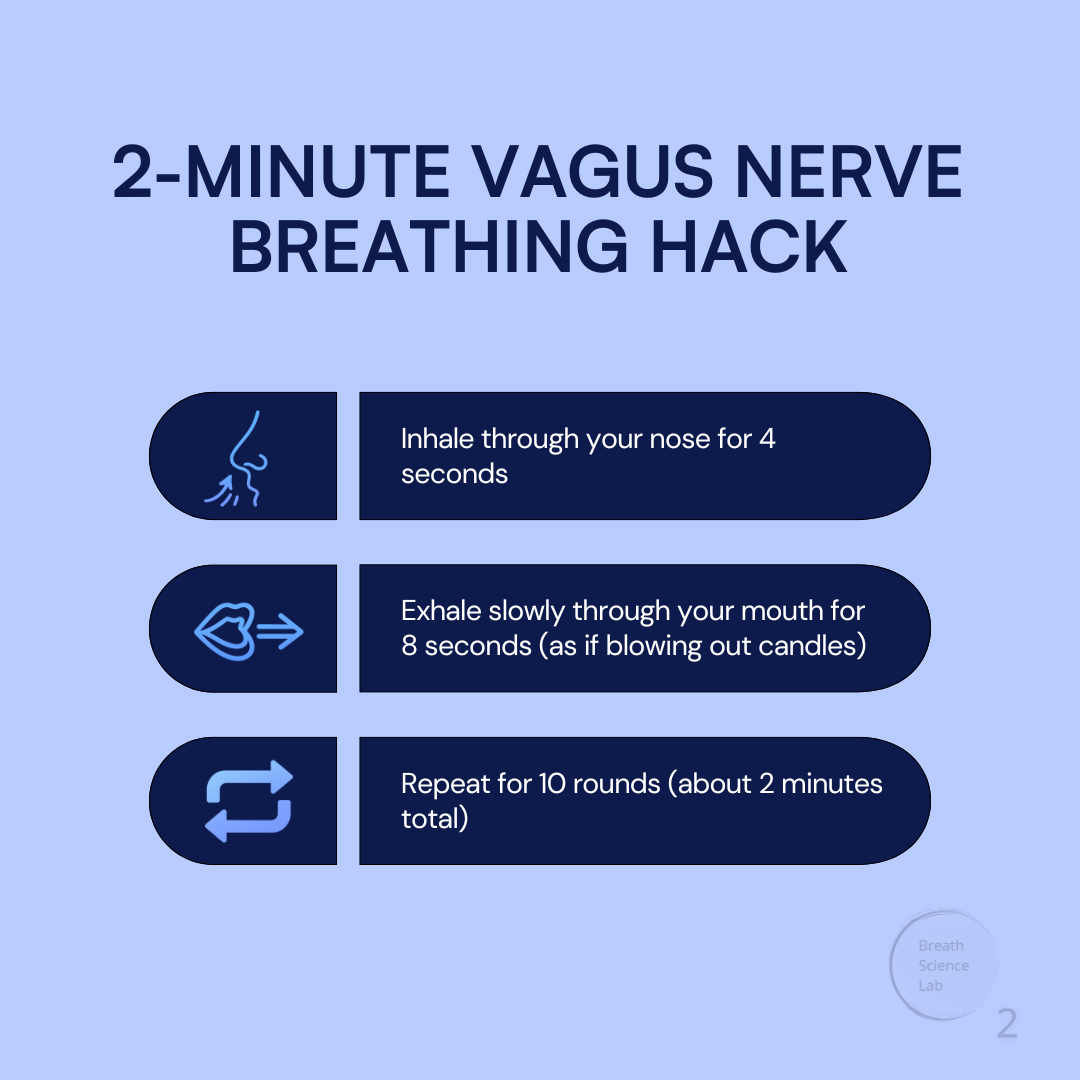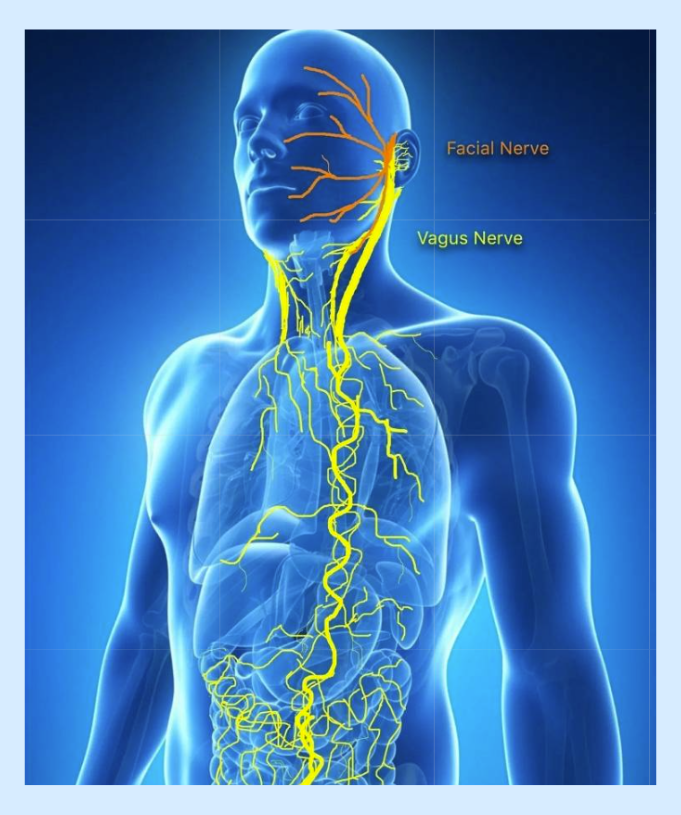The Vagus Nerve: Your Body’s Built-In Recovery Switch (Explained with Science + Simplicity)
A calm, practical guide to the vagus nerve — how it helps you relax and recover, and how to activate it naturally with breath, movement, and more.

What Is the Vagus Nerve (And Why Should You Care In The First Place)
You have a built -in recovery switch going down through your body, it's called the vagus nerve.
It flows from the base of your brain, down your neck, then branches out through your chest and gut. It touches a little bit of everything - heart, lungs, stomach and even your vocal cords.
This one nerve plays a massive role in your body's ability to relax, reset, and recover from stressful situations. It's part of your parasympathetic nervous system - the part that signals "safety"to the rest of your body to slows things down and come back to your baseline.
Why It Matters for Recovery and Resilience
Your vagus nerve is a key component of the parasympathetic nervous system (PNS), often reffered to as the "rest and digest" system. It is the opposite to the sympathetic nervous system's "fight or flight" response. It tells your body to relax and recover.
When your vagus nerve is functioning properly, it helps regulate:
- Heart rate and blood pressure
- Emotional responses
- Inflammation
- The body's ability to shift between "fight - or - flight" and "rest - and - digest" mode
It’s one of the key things that make your nervous system resilient.
Vagus Nerve & HRV: The Recovery Signal
If you’ve heard of HRV (heart rate variability), the vagus nerve is behind it.
A high HRV is a great sign - it means your body can adapt to stress easier. A sluggish vagus nerve usually means low HRV and a nervous system that has trouble letting go and activating the recovery mode.
Vagal tone refers to how strong or responsive your vagus nerve is. The better the tone, the easier it is to return to calm.
If you feel stuck in stress, can’t settle down, or your digestion is not working as it should - it means your vagus nerve probably needs some support.

How to Stimulate Your Vagus Nerve
Strengthening your vagal tone doesn't always mean you need a medical intervention; there are many techniques which can effectively stimulate the vagus nerve:
1. Deep Belly Breathing
Slow, deep belly breathing (aka diaphragmatic breathing) activates the vagus nerve, promoting a state of calm. Practicing deep breathing exercises lowers heart rate and blood pressure. It tells your nervous system that it's safe and it's time to switch to build and repair.
2. Cold Exposure
The cold can be very healing. Splashing cold water on the face or better yet taking a cold shower, can also activate the vagus nerve. The cold can shift the body from a sympathetic state ("fight or flight") to a parasympathetic state ("rest and digest"), which reduces stress and enhances recovery.
3. Humming, Singing, and even Gargling
Because the vagus nerve is conncted to the vocal cords - singing, humming, or gargling helps to stumulate it. This is due to its connections with the muscles in the throat. This, in turn, can promote relaxation and emotional well-being.
4. Meditation and Mindfulness
Mindfulness practices and meditation have proven to increase parasympathetic activity by calming the mind and reducing stress, thereby enhancing vagal tone. However, I found that if you are trying to combat present stress - breathwork will work better because it gives your mind something to do, making it easeir to complete an exercise. You also feel immediate results, even while you do it.
5. Physical Exercise
Regular, moderate exercise has been shown to improve vagal tone and HRV, contributing to better stress management and overall health. I personally love to start my morning with breathwork and complement it with a 5-10 minute exercise right after. It works great for enhancing my mood!
Try This 2-Minute Vagus Nerve Breathing Hack
If you’re feeling overwhelmed, foggy, or feel like you can't make a decission, here’s what to do:
🌀 Inhale (4 seconds) through your nose if you can, if not through your mouth
🌀 Exhale (8 seconds) through your mouth (as if blowing out candles)
🌀 Repeat for 10 rounds (about 2 minutes total)

🧠 Save this visual guide for later
While this 2 - minute breathing technique can bring immediate relief, consistent daily practice helps strengthen your vagal tone and resilience over time.
Visualizing the Vagus Nerve
If your want understand the vagus nerve's extensive reach, take a look at this diagram:

📷 Image Source: National Library of Medicine
This simplified anatomical illustration shows the vagus nerve (in yellow) connecting the brainstem to key organs across the chest and abdomen - highlighting its role as a communication superhighway for rest, digestion, and recovery.
Integrating Vagus Nerve Stimulation into Daily Life
Adding vagus nerve stimulation techniques into your daily routine doesn't have to be hard or time consuming:
Morning: You can start with a cold shower (or just cold water on the face) and follow it up with deep belly breathing.
Daytime: Take some short breaks and stretch or do light physical activity. If you can, try practicing mindfulness for a few minutes.
Evening: Do a few minutes of humming , whether it is while doing deep belly breathing or huming to your favorite relaxing song. It really works!
Consistancy is key. If you do these techniques, you can increase your body's ability to recover from stress, strengthen emotional regulation, and increase your overall health.
If any techniques feel aggravating or uncomfortable, pause and return to what feels grounding - even one gentle breath can be enough. Remember never force, go with what feels good.

